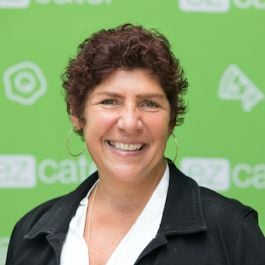
When self-care takes a back seat to work, that work suffers.
Leaders working 12-hour days might think they’re doing what’s best for the business, but if and when their mental and physical health declines, all of that hard work goes out the window. Tack on the added stress of managing a fully remote team during a pandemic, and the need for self-care becomes even more tantamount.
During times of stability, but especially now, leadership can come with stress and anxiety. Boston leaders intimate with this experience shared how they combat those feelings and offered advice on how other leaders can prevent burnout.
One of their main tips? Protect your time. Leaders should think about the hobbies and people that make them happy, then schedule time for them, whether that means spending time with children, exercising or cooking. Stick to those schedules as strictly as possible.
What self-care looks like for Kitty: When I think of and practice self-care, I see it as the ability to press pause on life, which is hugely important as we all meander our way through the shared trauma of COVID-19. Since going fully remote, the stresses of managing a workforce of over 180 team members was amplified.
The pressure to shift culture and working norms, communicate frequently and care for team members began to weigh on me. So I took time off. I needed to fill my own cup in order to be able to pour into others. I went off the grid and didn’t log in on that day or over that weekend, which was refreshing. It gave me the opportunity to breathe and sink into my own hobbies without the anxiety of what “needed to be done.”
I am the most important stakeholder I know.”
Balancing self-care and work at Panorama Education: As a later-in-life gym rat, I make sure to stay active during the week. Once the stay-at-home orders went into effect, I signed up for a virtual HIIT program that includes meal prep and at-home workouts. I hold myself accountable for following the program, which calls for six workouts a week. I don’t allow anyone or anything to disrupt that scheduled time, and there’s accountability in that. This one-hour block is just as important as a meeting with key stakeholders to me. And I wouldn’t dare miss this personal time because I am the most important stakeholder I know.
Advice for other leaders: Remember why we’re leaders. When we’re not role-modeling the practices that keep us energized, engaged and at our best, what are our teams doing? Lead from the front. If a team seems unmotivated, burnt out and stressed, I challenge leaders to look in the mirror. Do they feel the same way? It’s likely that they are.
Take a step back and ask, “How do I like to unwind?” Whatever the answer is, do it, then talk about it. Share it with direct reports, peers and the company CEO. Share it with family members and friends. Chances are, others will follow that lead, making the leader and everyone around them feel better.
What self-care looks like for McManus: I practice self-care by establishing a wellness routine that allows me to feel like I am fulfilling the roles that are most important to me. I focus on activities that bring me joy or provide balance.
Yoga, meditation, and clean eating are important to me, and I’m deliberate in creating space for them away from the house at studios and retreats. However, with most of those places closed and everyone working from home, I found my new self-care routine can be simpler than I previously thought. I get out of the house and love to take hikes around the Middlesex Fells. But even a stroll around my neighborhood makes a big difference.
I am most nourished when connecting with others so my self-care also includes things like TikTok with my daughter, virtual happy hours and weekly virtual game night with my cousins and siblings.
I plan my week to ensure I block off time for what is most important to me.”
Balancing self-care and work at Drizly: I learned about “choice management” vs. “time management” at a conference years ago and that was a game-changer for me. The key to ensuring I am making time for self-care is in planning. I love my work and care about the people at Drizly. Without planning for self-care, I would easily spend the entire day and night working.
On Sundays, I plan my week to ensure I block off time for what is most important to me, like bike rides with the kids, a dance-off with my team or just taking that walk. Most of us have the habit of scheduling what seems urgent, like big meetings or important tasks, but not things that are personally important and fulfill us; self-care must be given equal importance and intention. So blocking off time for the important, but not urgent, activities is paramount.
Advice for other leaders: If you are busy and feel burned out, it is typically because the work feels highly important. I remind myself that I am better for others when I am at my best, and I am at my best when I care for myself. Leaders should approach self-care like they would any other big project. Create a plan and execute. Even taking 10 minutes in the morning — before logging into the computer — to have a coffee outside and think about the day ahead can make a big difference.
What self-care looks like for Steinbeck: Self-care is something that I have been cultivating in my life for years. It’s a practice like any other habit. Knowing how to best relax and unwind takes self-reflection, trying new things and understanding the data about oneself.
Self-care practices built into Steinbeck’s week:
- Yoga
- Meditation
- Listening to podcasts
- Chatting with friends
- Reading
- Diffusing essential oils
- Drinking tea
- Walking outside
- Taking a bath
Balancing self-care and work at Indigo: I’m not striving for perfection, I’m striving for consistency. I’ve built a routine around small stuff that makes me happy. If I miss a yoga practice or eat my feelings with cake, I don’t sweat it. I have enough healthy habits and do enough things that make me feel good throughout a week that a slip-up doesn’t derail me. And if I go too long without doing some of these things, my emotional state will tell me.
Right now, I have a lot of extra time. I’m trying to take advantage of that so boredom or anxiety doesn’t take over and self-care practices are a great way to spend that extra time.
Advice for other leaders: You cannot give what you do not have. A leader’s investment in themselves is an investment in their team and company. Feeling burnt out is a great indicator that self-care isn’t being made a priority.
But from there, it’s easy to act. Emotions are a great guidance system, so pay attention to them. Ask, “What are five things — however big or small — that can bring me happiness in a week, and how often am I doing them?” If these things aren’t part of a weekly routine, add them. Saying “I don’t have time,” is a common pitfall that is no longer relevant for a lot of folks. Many of us will never have more “me time” than we do right now.
What self-care looks like for Allo: Self-care is so important, especially in this strange time. There are four things I do to maintain, starting with getting a good night’s sleep. I exercise daily, putting in 30 to 45 minutes on my bike to get my day started. Frequently throughout the day, and deliberately at the beginning and end of every call, I take three deep breaths. And finally, I create boundaries between work and home. I change clothes, move to other spaces, keep my schedule and communicate to my team when I’m available and when I’m offline.
Give yourself breaks, several throughout the day.”
Balancing self-care and work at ezCater: I build self-care into my schedule every day. I don’t get on the computer before 8:30 a.m. My morning between 6 and 8:30 a.m is a sacred time for exercise and whatever else I need to start my day. I check in with my breath and feelings multiple times a day, at least once during each meeting. If I have a tough day, I remind myself I am human, imperfect and that humans are messy.
Advice for other leaders: Accept feelings, whatever they are; mine come in waves. It is OK to not be OK. Know you are not alone. Leaders should also reach out to the people closest to them if they need to talk. Since I live alone, I schedule time to text or speak with a loved one at the end of every work day to bridge work and home.
Lead by example. A leader cannot care for others if they do not care for themselves. Give yourself breaks, several throughout the day. Or take a mental health day. They should encourage themselves and others on their team to look after each other; do check ins and drive-by calls, shorten Zoom meetings or take turns leading depending on everyone’s energy.
Stay present and don’t rush into decisions. Slowing down and setting realistic expectations is key for me to maintain my energy and to lead with focus and empathy.
What self-care looks like for Sammut: For me, self-care starts with remembering what gives me energy and brings me joy. As a parent, starting my day right means connecting with each of my two young kids in the morning before I log on for work. Connecting with my kids is all about being present. It doesn’t matter what we’re doing — it could be making breakfast or cleaning up toys — but that I’m there, focused on them and not on my phone for those early moments of the day. Starting my day by practicing presence helps me maintain focus as the rest of my day unfolds. And to help retain that focus, I take one or two meetings a day while on a walk.
My calendar treats self-care commitments with the same weight as work events.”
Balancing self-care and work at LiveRamp: I use a single calendar for both work and my personal life. I find it helpful to have both sets of commitments in one place to ensure I’m not double-booking. That practice is fairly tactical, but my second key practice is actually a mindset: I believe that taking care of myself enables me to be my best at work and at home. When I recenter on that belief, it makes self-care as much about doing well by others as it is about doing well by myself. I find that idea motivating and my calendar treats self-care commitments with the same weight as work events.
Advice for other leaders: Again, taking care of ourselves enables us to be our best at work and at home. There are times when life unexpectedly disrupts my self-care routine. In those moments, I find that mindsets matter most. My schedule may not always be in my control, but I have a great deal of agency over how I think and make sense of what’s going on around me. In the end, I find that staying positive and keeping things in perspective is the ultimate form of resilience and self-care.
What self-care looks like for Surr: Self-care means doing something that is both meditative and healthy. For example, I try to take a long walk every day. I’m fortunate to live in a town that has great access to nature. Even if the weather is unpleasant, it’s a balm to take time to notice how the plants, trees and animals change as we move through the spring season.
My wife and I also like to cook healthy things together. The pandemic has created opportunities for us to try new things, like we’re living in an episode of “Iron Chef.” There are so many ambiguous and complex issues that we deal with at work. Having something that I can plan, execute and enjoy in a small amount of time is good for the soul.
Self-care means doing something that is both meditative and healthy.”
Balancing self-care and work at Ellevation Education: Self-care was hard for me at the start of the pandemic. The company had a lot of immediate work to do to support the teachers, administrators and kids we serve. And I felt off-kilter.
To get back on track, I took time to unplug based on my team being two time zones ahead of me. It was easy for me to start before sunup to meet their timezone, and continue working until sundown. Since the spring brings on longer days, I started taking my afternoon walks at 5 p.m. EST, 3 p.m. MST. I often log back on after I get back, but I’m much better at triaging what’s urgent after I’ve taken that time to step off the work treadmill for a self-care break.
Advice for other leaders: Remember to practice what you preach. I know my team members have had burn-out moments as they’ve tackled new, intense projects and adjusted to the complexities of working from home. They might feel less comfortable taking PTO or doing other things to recharge if I didn’t show that taking personal time was necessary and important. Be a good role model.
Without a full battery, leaders will do a disservice to their business and team. They will be lacking the energy needed to drive the innovation and the calm, empathetic communication that will underline success now and in the future.
What self-care looks like for Conley: For me, self-care includes two major things: separation between work and my personal life, as well as daily physical activity. Prior to COVID-19, I had more of a physical separation between work and home that has become increasingly challenging during this pandemic. I also enjoyed my walks from the commuter boat to the office and while traveling, walks in the airport and the cities I visited.
Dusting off the rarely used treadmill in my basement has helped me to continue my walks when there is inclement weather. When it’s nice outside, I explore previously untraveled roads and paths in my small town. The elimination of my commute and busy travel schedule has made me appreciate the natural resources just a short walk from my home even more.
All of my work related materials and my laptop are confined to one room.”
Balancing self-care and work at Kyruus: All of my work related materials and my laptop are confined to one room in the house. When I am in that room I’m “at work.” I have resisted the temptation to work in different areas of the house or outside and this has helped me to establish work and home-life separation.
Advice for other leaders: During this strange time of drastic changes in everyone’s daily routines, I think it’s important to find creative ways to adjust and mold the self-care practices that have previously worked into this new situation.
What self-care looks like for McDonough: I am committed to eating healthy food, avoiding high sugar foods and too much caffeine. I am also focused on drinking more water. I exercise daily with yoga and found YouTube to be a great resource for virtual yoga sessions.
Recognizing an issue and course-correcting is a sign of strength and resilience.”
Balancing self-care and work at Acquia: I maintain a daily routine as much as is possible. For example, I continue to wake up at a regular time even while working from home. I take a walk in the morning, similar to walking from the train to the office, only in the backyard of my home. I use my calendar to schedule time for stretch breaks and exercise. If I schedule it, I know it’s more likely to happen.
Advice for other leaders: Taking care of oneself and leading by example makes for better team leaders and inspires others.
When feeling burnt out, create a “reset” plan that includes increasing positive coping behaviors that have worked in the past, as well as activities that align with your values. Recognizing an issue and course-correcting is a sign of strength and resilience. Pushing through and conquering these challenges makes leaders come out stronger on the other side.
What self-care looks like for Lynch: I think of self-care in two buckets: the physical and mental. Physically, self-care means choosing nutritious food and getting movement in every day through a workout class or a walk outside. It also means staying mentally present. When I feel fear and worry creep in, I know it’s important to make time to take a step back and create space for myself. So I’ll take a night off, move meetings around or go for a long walk. Maintaining a healthy perspective is key to staying well mentally and also making good business decisions.
Pushing through burnout is ineffective and good for no one.”
Balancing self-care and work at Wishroute: I start every day with mediation. Before I look at my phone, I reflect and let any stress from the previous day or night fall away so I can start the day fresh with the best perspective possible. I also try to leave an hour open during midday for some sort of exercise, like a quick workout video, run or walk. It’s important to get up and move to keep from sitting all day.
Advice for other leaders: When our energy is high and our perspective is good, we’re significantly more efficient and effective. Taking time to get in that zone pays off two or three times over, every time. Pushing through burnout is ineffective and good for no one.
























